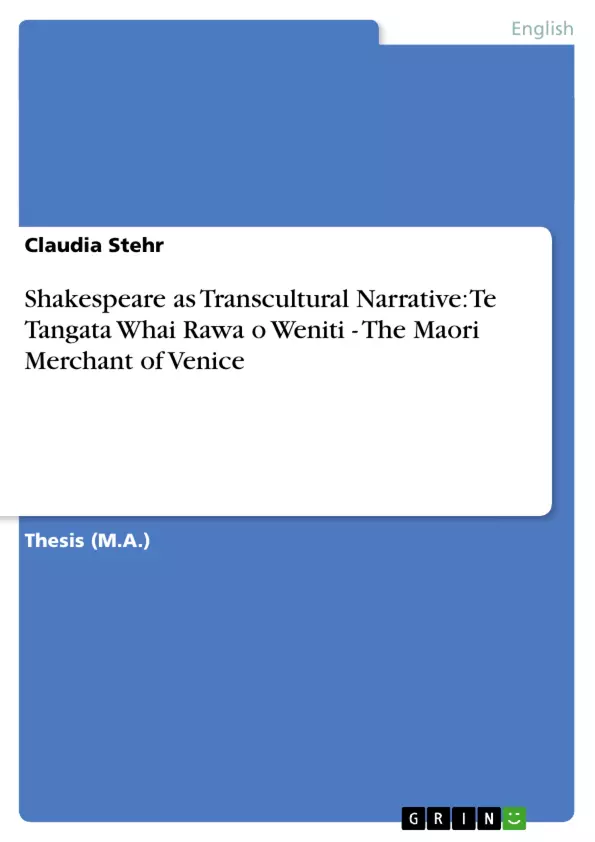This thesis adds an extended approach to the aspect of ‘Other’ Shakespeares with the Māori film adaptation of Te Tangata Whai Rawa o Weniti – The Maori Merchant of Venice as a new form of a local as well as global Shakespearean appropriation. It examines how Māori culture and identity is shown in the film, by using Shakespeare as an international trademark for their own means of fostering Māori identity and to make this language and culture internationally known to a worldwide Shakespeare audience. At the same time, the thesis scrutinises how other global cultural elements are interwoven into the screen adaptation, which effects a hybridisation of Shakespeare and transcends the film into a transcultural space. Through this transculturality it is argued that the screen version overcomes the binary notion of Self/Other as ‘Western’ and ‘Indigenous’ culture are interwoven into one equal network.
The thesis draws on a variety of theories and methodologies. It is embedded in the concepts of postcolonial theory developed by Edward Said and Homi Bhabha and the central theme of hybrid productions in postcolonialism, but it also consults new historicism, cultural studies and film theory. These theories and concepts are not only viewed from a Western perspective but are combined with Pacific and Māori cultural and film theory. The blend is vital to this research, as this Shakespeare adaptation has its origins in the Pacific and is made by Māori people utilising Māori cultural elements. Therefore, it is essential to connect Western with ‘Indigenous’ perspectives to acquire a balanced outcome...
Inhaltsverzeichnis (Table of Contents)
- Introduction
- General Assumptions
- Objectives
- Outline
- Definitions
- Shakespeare in New Zealand
- Shakespeare as Colonial ‘Mimicry’
- Towards a National Theatre
- Shakespeare Becoming a ‘Kiwi’
- Shakespeare and Māori Theatre
- Māori Cultural Identity – A Transcultural Identity?
- 'Being a Maori is…'
- Transculturality
- Transcultural Māori Identity
- Te Tangata Whai Rawa o Weniti – A Far-Reaching Film Project
- The 'Man who colonised Shakespeare'
- A Maori Film with Concrete Purpose
- National and International Reviews
- Detailed Film Analysis
- From Playscript to Screenplay…
- Exposition/ Sequence 0
- Act I/Sequence 1
- Act II/Sequence 2
- Act III/Sequence 3
- Act IV/Sequence 4
- Act V/Sequence 5
- Tradition of Shakespearean Merchant Screen Adaptations
- Transcultural Elements in Te Tangata Whai Rawa o Weniti
- 'Transcultural Languages'
- 'Transcultural Bodies'
- 'Transcultural Sites'
Zielsetzung und Themenschwerpunkte (Objectives and Key Themes)
This master's thesis examines the transcultural aspects of the Māori adaptation of Shakespeare's *The Merchant of Venice*, titled *Te Tangata Whai Rawa o Weniti*. The research aims to analyze the film's adaptation of the original play and explore how it reflects and engages with Māori cultural identity and transculturality.
- Shakespeare's work in a New Zealand context
- Transculturality and Māori identity
- The film adaptation process and its cultural significance
- Transcultural elements within the film, including language, body, and site
- The impact of the film on Māori cultural expression and representation
Zusammenfassung der Kapitel (Chapter Summaries)
- Introduction: This chapter introduces the research project, outlining the general assumptions and objectives of the study, as well as providing an overview of the thesis's structure and key definitions.
- Shakespeare in New Zealand: This chapter explores the history of Shakespeare's reception in New Zealand, examining the evolution of his work within a colonial context and its subsequent integration into a national cultural landscape. The chapter also investigates the development of Māori theatre and its relationship to Shakespeare's plays.
- Māori Cultural Identity – A Transcultural Identity?: This chapter delves into the concept of Māori identity and its complex relationship to transculturality. It examines the ways in which Māori cultural practices and beliefs have been influenced by external forces, while simultaneously maintaining a strong sense of cultural distinctiveness.
- Te Tangata Whai Rawa o Weniti – A Far-Reaching Film Project: This chapter focuses on the film adaptation of *The Merchant of Venice*. It provides background information on the film's production, highlighting the motivations and objectives behind the project. The chapter also discusses the film's reception within New Zealand and internationally.
- Detailed Film Analysis: This chapter presents a detailed analysis of the film adaptation of *Te Tangata Whai Rawa o Weniti*. The chapter examines the film's structure, narrative choices, and visual elements, highlighting how these elements reflect and engage with Māori cultural themes and values.
- Transcultural Elements in Te Tangata Whai Rawa o Weniti: This chapter analyzes the transcultural elements present in the film, focusing on the interplay between language, body, and site. The chapter explores how these elements contribute to the film's unique cultural and aesthetic expression.
Schlüsselwörter (Keywords)
The key focus areas of this work include Māori identity, transculturality, Shakespearean adaptation, film analysis, Māori theatre, and *The Merchant of Venice*. The research explores the intersections of these concepts within the context of New Zealand and the Māori cultural landscape, particularly within the specific example of the film *Te Tangata Whai Rawa o Weniti*.
- Quote paper
- Magistra Artium Claudia Stehr (Author), 2006, Shakespeare as Transcultural Narrative: Te Tangata Whai Rawa o Weniti - The Maori Merchant of Venice, Munich, GRIN Verlag, https://www.grin.com/document/73758



